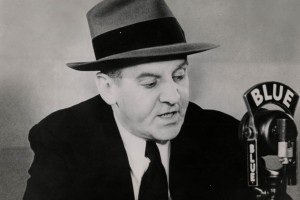‘The March of Time’ was a series of ground-breaking short films on current events, sports, politics, society, younameit, which played before movies in theaters nationwide from 1935 to 1967. Produced by Time, Inc., publisher of Time, Life and Fortune magazines, the 20 minute documentaries first aired as radio programs on CBS in 1931. The news was delivered with professional actors impersonating public figures. (Agnes Moorehead, aka Endora on Bewitched, played Eleanor Roosevelt. So cool.)
That dramatic approach to covering events and issues of the day carried through to the film newsreels. It became a trademark, and a source of consternation to critics and journalists who didn’t know what to make of the mixture of fact, fiction and propaganda.
The film’s most unusual feature was its re‐creation or staging of events that had taken place but which had not been photographed by newsreel cameras. De Rochemont argued that he had the same right to interpret and clarify news events with staged scenes as a re‐write man on a newspaper had with words to make sense out of a reporter’s notes. He used both professional and amateur actors to impersonate famous people on the screen, and then blended the staged scenes with real newsreel footage. In time, the series became so celebrated that real celebrities were persuaded to play themselves, re‐enacting events in which they had participated.
For its production of the “Atomic Power” episode in 1946, for example, J. Robert Oppenheimer, Albert Einstein, Enrico Fermi and other leading scientists re‐enacted the roles they had played in the Manhattan Project. In one scene, James Conant and Vannevar Bush are shown lying on the sand in New Mexico, shaking hands after the successful explosion of the first atomic bomb. In reality, they had been photographed lying on the floor of a garage in Boston. The staging of scenes was never acknowledged on the screen although, of course, professional journalists and filmmakers were well aware of the techniques employed. By 1940 the series was so well known that it was parodied by Orson Welles in his production of CITIZEN KANE, including an imitation of the voice of Westbrook Van Voorhis, “The Voice of Time.”
Or for a more recent reference, think South Park: Bigger, Longer and Uncut with its ‘The March of War’ (Eat Snacky Smores) newsreels covering (and exacerbating) the growing anti-Canadian war fever.
This year to celebrate the 75th anniversary of ‘The March of Time’ series, the HBO Archives, the National Gallery of Art, The Museum of Modern Art and Turner Classic Movies (TCM) are collaborating on showings of the films. MoMA is grouping the newsreels by theme and showing them the first 10 days of September (pdf schedule) followed by panel discussions with experts on the archives.
If that doesn’t happen to be convenient, Sunday, September 5, Turner Classic Movies will air some of the most famous titles between 8:00 PM and midnight. Some of the newsreels aired will be: “Dust Bowl,” “Inside Nazi Germany” (showed in 1937, it was the first anti-Nazi program shown in the isolationist U.S.), “Youth in Crisis,” “Palestine Problem,” and “Problem Drinkers”. This is the first time TCM has ever shown these movies so fire up your DVRs.
You can read more about planned events, view and discuss clips on ‘The March of Time’ Facebook page.
